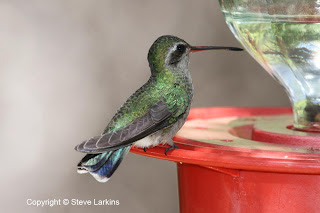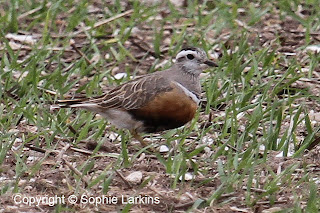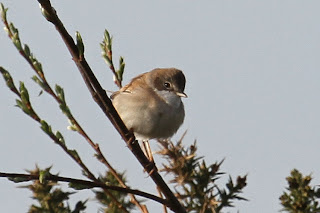It is always great to see one of our favourite birds - the Wheatear on its annual migration to the higher ground of northern and western areas of the UK, from its wintering territories in central Africa.
There were at around 6-8 pairs of Wheatears on Bury Down today and we got a few reasonable pictures, especially when a bold male decided to land on one of the fence posts adjacent to where we were standing!
The main reason for the visit to Bury Down was to see the Dotterel, but the Wheatears were a welcome bonus! Shame it was freezing cold up on the Ridgeway today with the same nagging north easterly wind which just won't go away this year. The car temperature gauge was only reading 8C!
Sunday 28 April 2013
Dotterel on Bury Down, West Berkshire
We were very pleased to spot the Dotterel today. It has been seen for a couple of days on Bury Down (SU4884) in West Berkshire, just off the Ridgeway path east of the main parking area at the top of the Downs on an adjoining farmer's field. It was never very close, so the picture (left) is significantly cropped.
Dotterels are summer visitors to Scotland, so this bird has probably stopped off on migration and is a rare and unusual bird sighting in Berkshire. The RSPB website shows the bird as a passage migrant in Norfolk, so this is quite a way off its regular territory. The Dotterel is a Blackbird sized bird which has an orange breast and black and white horizontal markings, together with a striking grey and black upper body and head. The UK population is only 500-700 birds, so Dotterels are a notable rarity.
Dotterels are summer visitors to Scotland, so this bird has probably stopped off on migration and is a rare and unusual bird sighting in Berkshire. The RSPB website shows the bird as a passage migrant in Norfolk, so this is quite a way off its regular territory. The Dotterel is a Blackbird sized bird which has an orange breast and black and white horizontal markings, together with a striking grey and black upper body and head. The UK population is only 500-700 birds, so Dotterels are a notable rarity.
Friday 26 April 2013
Broad Billed Hummingbirds
 The miserable UK March weather made us decide to head off to warmer climes for Easter and our chosen destination was Phoenix, Arizona in America's beautiful south west. When we left the UK on 1st April it was only 2C and trying to snow.That all changed when we got to Arizona - with some days topping 34C!
The miserable UK March weather made us decide to head off to warmer climes for Easter and our chosen destination was Phoenix, Arizona in America's beautiful south west. When we left the UK on 1st April it was only 2C and trying to snow.That all changed when we got to Arizona - with some days topping 34C!Little did we know when we booked the trip that Arizona, and particularly south east Arizona is a Mecca for birders and during the summer months (May - September) it has the largest number of Hummingbird species ever recorded in the United States, some 14 species in fact - including some rare species which are normally residents south of the Mexican border.
Hummingbirds recorded at Beatty's Guest Ranch at Miller Canyon, AZ include: Allen's, Anna's, Berylline, Black-chinned, Blue-throated,Broad-billed, Broad-tailed, Calliope, Costa's, Lucifer, Magnificent, Rufous, Plain-capped Starthroat, Violet-crowned, White-Eared.
Unfortunately the unseasonably cool winter in the Phoenix Metropolitan Area seemed to have hit Hummingbird numbers and some plants had also been killed by the severe frosts in early 2013.
As we were staying in Scottsdale, a trek to Miller Canyon was too far on this occasion, but we did discover an excellent nearby location for Hummingbird viewing - Boyce Thompson Arboretum, which was about 50 miles east of Phoenix on I-60 (a comfortable hour's drive). With a little patience we were rewarded with great views of Broad Billed Hummingbirds in their natural environment in the Boyce Thompson Hummingbird Garden.
Sunday 21 April 2013
Whitethroat Sightings
Greenham Common was alive with birds today as I enjoyed the pleasant spring sunshine with a lengthy early morning walk.
One sighting of particular interest during my two hour walk were several pairs of Whitethroats. One pair was first spotted in the central runway area and then a further sighting was made just to the west of the cordoned off area for ground nesting birds near EPC. This area adjoins woodland. Each sighting was in dense thickets of undergrowth with one in Gorse.
The Whitethroat is a summer visitor to the UK and has Amber Status, so it is nice to see this uncommon bird on Greenham Common (a first for me!).
These birds spend winter in sub-Saharan Africa, so they may still be on migration to other parts of the UK, stopping off at Greenham Common - or if we are lucky they may stay for the summer.
Whitethroats are about Robin size and the bird photographed was quite vocal, moving from bush to bush.
One sighting of particular interest during my two hour walk were several pairs of Whitethroats. One pair was first spotted in the central runway area and then a further sighting was made just to the west of the cordoned off area for ground nesting birds near EPC. This area adjoins woodland. Each sighting was in dense thickets of undergrowth with one in Gorse.
The Whitethroat is a summer visitor to the UK and has Amber Status, so it is nice to see this uncommon bird on Greenham Common (a first for me!).
These birds spend winter in sub-Saharan Africa, so they may still be on migration to other parts of the UK, stopping off at Greenham Common - or if we are lucky they may stay for the summer.
Whitethroats are about Robin size and the bird photographed was quite vocal, moving from bush to bush.
Subscribe to:
Posts (Atom)






